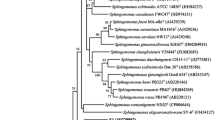Abstract
Alkyl-substituted aniline is an important aniline derivative that may be associated with serious environmental risks. Previously, Sphingobium baderi DE-13, a bacterium that can mineralize alkyl substituted anilines such as 2,6-dimethylaniline, 2,6-diethylaniline, 2-methyl-6-ethylaniline, 2-methylaniline, and 2-ethylaniline, was isolated from active sludge. Here, we report the complete genome sequence of strain DE-13. It contains one circular chromosome and eight circular plasmids with total 4,583,422 bp and GC content of 62.41%. The reported and predicted genes involved in the catabolism of alkyl-substituted anilines are indicated. This study will provide insights into the bacterial catabolism of alkyl substituted anilines.


Similar content being viewed by others
References
Breugelmans P, Leroy B, Bers K, Dejonghe W, Wattiez R, De Mot R, Springael D (2010) Proteomic study of linuron and 3,4-dichloroaniline degradation by Variovorax sp. WDL1: evidence for the involvement of an aniline dioxygenase-related multicomponent protein. Res Microbiol 161:208–218
Calaf RE, Pena J, Paytubi S, Blount BC, Posada de la Paz M, Gelpi E, Abian J (2001) Determination of aniline derivatives in oils related to the toxic oil syndrome by atmospheric pressure ionization-tandem mass spectrometry. Anal Chem 73:3828–3837
Cerniglia CE, Freeman JP, Van Baalen C (1981) Biotransformation and toxicity of aniline and aniline derivatives of cyanobacteria. Arch Microbiol 130:272–275
Cheng M, Meng Q, Yang Y, Chu C, Chen Q, Li Y, Cheng D, Hong Q, Yan X, He J (2017) The two-component monooxygenase MeaXY initiates the downstream pathway of chloroacetanilide herbicide catabolism in sphingomonads. Appl Environ Microbiol 83:e03241-16
Chitsaz H, Yee-Greenbaum JL, Tesler G, Lombardo MJ, Dupont CL, Badger JH, Novotny M, Rusch DB, Fraser LJ, Gormley NA, Schulz-Trieglaff O, Smith GP, Evers DJ, Pevzner PA, Lasken RS (2011) Efficient de novo assembly of single-cell bacterial genomes from short-read data sets. Nat Biotechnol 29:915–921
Dong W, Chen Q, Hou Y, Li S, Zhuang K, Huang F, Zhou J, Li Z, Wang J, Fu L, Zhang Z, Huang Y, Wang F, Cui Z (2015) Metabolic pathway involved in 2-methyl-6-ethylaniline degradation by Sphingobium sp. strain MEA3-1 and cloning of the novel flavin-dependent monooxygenase system meaBA. Appl Environ Microbiol 81:8254–8264
Fuchs K, Schreiner A, Lingens F (1991) Degradation of 2-methylaniline and chlorinated isomers of 2-methylaniline by Rhodococcus rhodochrous strain CTM. J Gen Appl Microbiol 137:2033–2039
Kitagawa W, Kimura N, Kamagata Y (2004) A novel p-nitrophenol degradation gene cluster from a gram-positive bacterium, Rhodococcus opacus SAO101. J Bacteriol 186:4894–4902
McCarthy A (2010) Third generation DNA sequencing: pacific biosciences’ single molecule real time technology. Chem Biol 17:675–676
Quail MA, Smith M, Coupland P, Otto TD, Harris SR, Connor TR, Bertoni A, Swerdlow HP, Gu Y (2012) A tale of three next generation sequencing platforms: comparison of Ion Torrent, Pacific Biosciences and Illumina MiSeq sequencers. BMC Genom 13:341
Wu WT, Zhang L, You SL (2016) Catalytic asymmetric dearomatization (CADA) reactions of phenol and aniline derivatives. Chem Soc Rev 45:1570–1580
Acknowledgements
This study was fund supported by the National Natural Science Foundation of China (Grant Numbers 31270157, 31470225, and 31500082) and the Natural Science Foundation of Jiangsu Province (No. BK20141366).
Author information
Authors and Affiliations
Corresponding author
Rights and permissions
About this article
Cite this article
Cheng, M., Li, Y., Ma, Y. et al. Complete Genome Sequence of Sphingobium baderi DE-13, an Alkyl-Substituted Aniline-Mineralizing Bacterium. Curr Microbiol 75, 27–31 (2018). https://doi.org/10.1007/s00284-017-1346-3
Received:
Accepted:
Published:
Issue Date:
DOI: https://doi.org/10.1007/s00284-017-1346-3




